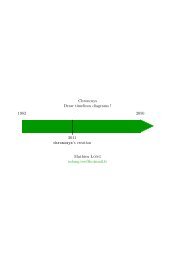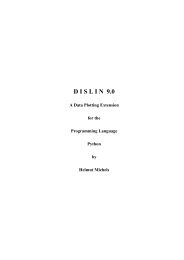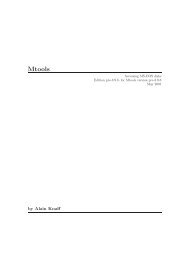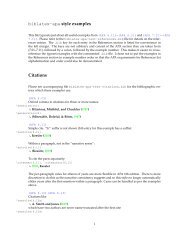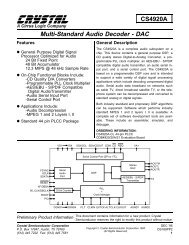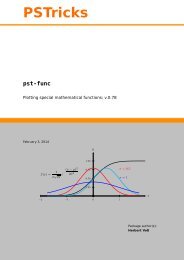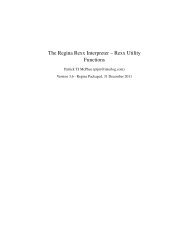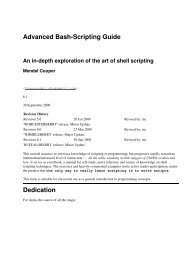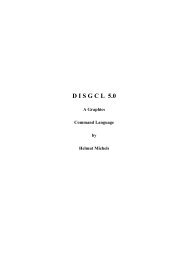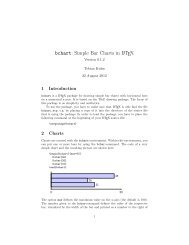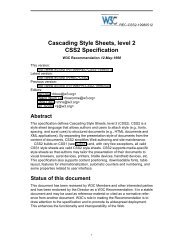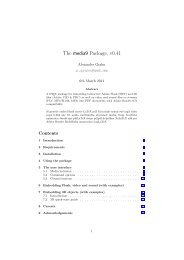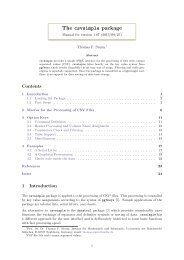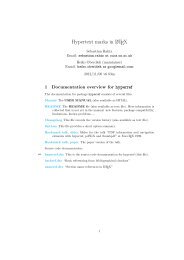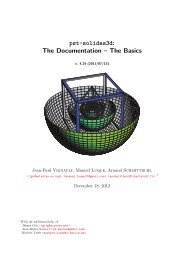A New Loop Optimizer for GCC
A New Loop Optimizer for GCC
A New Loop Optimizer for GCC
Create successful ePaper yourself
Turn your PDF publications into a flip-book with our unique Google optimized e-Paper software.
A <strong>New</strong> <strong>Loop</strong> <strong>Optimizer</strong> <strong>for</strong> <strong>GCC</strong><br />
Zdeněk Dvořák<br />
SuSE Labs<br />
dvorakz@suse.cz, http://atrey.karlin.mff.cuni.cz/˜rakdver/<br />
Abstract<br />
It is generally known that most of the time of<br />
programs is spent in a small portion of code<br />
([HP]). Those small but critical areas usually<br />
consist of loops, there<strong>for</strong>e it makes sense to expect<br />
the optimizations that directly target loops<br />
to have a great effect on program per<strong>for</strong>mance.<br />
Indeed optimizations to improve the efficiency<br />
of scheduling, decrease a loop overhead, optimize<br />
memory access patterns and exploit a<br />
knowledge about a structure of loops in various<br />
other ways were devised; see [BGS] <strong>for</strong><br />
a survey. Certainly no seriously meant compiler<br />
may ignore this. <strong>GCC</strong> contains a loop<br />
optimizer that supports the following optimizations:<br />
One of the most important compiler passes is<br />
a loop optimization. The <strong>GCC</strong>’s current loop<br />
optimizer is outdated and its per<strong>for</strong>mance, robustness<br />
and extendibility are unsatisfactory. A<br />
goal of the project is to replace it with a new<br />
better one. In this paper we discuss the design<br />
decisions – the choice of used data structures<br />
and algorithms, usage and updating of auxiliary<br />
in<strong>for</strong>mation,. . . Then we describe the current<br />
state with emphasis on still unsolved problems<br />
and outline the possibilities <strong>for</strong> further<br />
continuation of the project, including replacing<br />
the remaining parts of the old optimizer and introducing<br />
new low-level (RTL based) and highlevel<br />
(AST based) optimizations.<br />
Introduction<br />
• <strong>Loop</strong> invariant motion that moves invariant<br />
computations out of loops.<br />
• Strength reduction, induction variable<br />
elimination and various other manipulations<br />
with induction variables like fitting<br />
into machine addressing modes.<br />
• Doloop optimization, i.e. usage of low<br />
overhead loop instructions if a target machine<br />
provides them.<br />
• Prefetching of arrays used inside loops to<br />
reduce cache miss penalties.<br />
• Unrolling of loops to reduce loop overheads,<br />
improve the efficiency of scheduling<br />
and increase sequentiality of a code.<br />
We refer to this loop optimizer as the old one<br />
in the rest of the paper.<br />
The importance of loop optimizations has been<br />
recognized <strong>for</strong> a long time and the old loop<br />
optimizer was added to <strong>GCC</strong> very early (a<br />
copyright notice in the loop.c file dates it<br />
to 1987). The lack of knowledge about the<br />
optimization as well as the lack of computing<br />
power lead to several design choices that were<br />
un<strong>for</strong>tunate and today cause the optimizer to be<br />
much less powerful than it could be. They also<br />
cause other problems concerning its robustness,<br />
extendibility and restrictions imposed on<br />
the other optimizers. This lead us to decide to
44 • <strong>GCC</strong> Developers Summit<br />
replace it by a new one by rewriting some parts,<br />
adapting some parts <strong>for</strong> a new infrastructure<br />
and extending it by new important optimizations.<br />
We refer to the goal of our ef<strong>for</strong>ts as the<br />
new loop optimizer in the rest of this paper.<br />
The paper is structured as follows: In the section<br />
1 we investigate the structure of the old<br />
loop optimizer and problems with it. In the<br />
section 2 we discuss goals of the project to replace<br />
it and the high-level design choices of the<br />
new loop optimizer. Then we continue by providing<br />
the detailed description of the current<br />
state of the new loop optimizer, including the<br />
changes made in the loop analysis. In the following<br />
section 3 we describe used data structures<br />
and algorithms to update them. In the<br />
section 4 we summarize a status of the project,<br />
provide some benchmark results and state our<br />
future goals.<br />
1 The Old <strong>Loop</strong> <strong>Optimizer</strong><br />
The loop optimizer was added to <strong>GCC</strong> very<br />
early. Due to the lack of a computing power<br />
(and partially also the lack of knowledge) in<br />
those times, it has several features that are quite<br />
unusual <strong>for</strong> modern compilers.<br />
Firstly the loop discovery is based on notes<br />
passed from the front-end. This approach is<br />
very fast, but the considered loops are there<strong>for</strong>e<br />
required to <strong>for</strong>m a contiguous interval in<br />
the insn chain and to fit into one of a few special<br />
shapes (of course covering all of the most<br />
important cases). The loops created by nonloop<br />
constructs (gotos, tail recursion, . . . ) are<br />
not detected at all. Optimization passes be<strong>for</strong>e<br />
the loop optimizer are required to preserve the<br />
shape of loops and the placement of loop notes.<br />
Most of them <strong>for</strong>tunately do not modify control<br />
flow graph, but those few that do are complicated<br />
and restricted by this need.<br />
Additionally sometimes this in<strong>for</strong>mation is not<br />
updated correctly, there<strong>for</strong>e it must be verified<br />
in the loop optimizer itself and the offending<br />
loops are ignored. This makes us miss some<br />
more optimization opportunities.<br />
The second problem is the handling of jumps<br />
inside loops. The global (not specific to a single<br />
pass) control flow graph was introduced<br />
into <strong>GCC</strong> very lately (2000), and the loop optimizer<br />
works over the insn chain only. Consequently<br />
the effects of branches are estimated<br />
mostly by simple heuristics and results of loop<br />
invariant and induction variable analyses tend<br />
to be overly conservative.<br />
As a side issue, the unroller does not update<br />
control flow graph, <strong>for</strong>cing us to rebuild it.<br />
This prevents us to gather a profiling feedback<br />
be<strong>for</strong>e the loop optimizer, as this in<strong>for</strong>mation<br />
is stored in control flow graph. There<strong>for</strong>e we<br />
cannot use it in the loop optimizer itself and in<br />
the previous passes (most notably GCSE and<br />
loop header duplication).<br />
The unroller uses its own routines to copy the<br />
insn stream, creating an unnecessary code duplication<br />
with the other parts of the compiler.<br />
Any single of these problems could probably<br />
be addressed separately by modifying the relevant<br />
code. Considering them together it seems<br />
to be easier to write most of the optimizer<br />
again from scratch. Some parts can just be<br />
adapted <strong>for</strong> a new infrastructure (the decision<br />
heuristics and execution parts of the invariant<br />
motion and induction variable optimizations,<br />
the whole doloop optimization pass), but the<br />
greatest part has too deeply inbuilt expectations<br />
about a loop shape with respect to the insn<br />
chain to be usable. We discuss the plans concerning<br />
this rewrite in more detail in the following<br />
sections.<br />
The source of other complications is the low<br />
level of RTL. During the translation to RTL,<br />
some of the in<strong>for</strong>mation about possibility to
<strong>GCC</strong> Developers Summit 2003 • 45<br />
overflow and types of the registers is lost and<br />
we are <strong>for</strong>ced to either rediscover it through<br />
nontrivial analysis, use conservative heuristics,<br />
produce a suboptimal code containing unnecessary<br />
overflow checks or produce a possibly<br />
incorrect code. None of these options is particularly<br />
good. It would also make dependency<br />
analysis quite complicated – it is not present<br />
in <strong>GCC</strong> yet, and the optimizations that require<br />
it (the loop reorganization, the loop fusion,<br />
. . . ) are missing. While the current project<br />
is mostly RTL based, it will be necessary to<br />
address these issues in near future. There are<br />
already some ef<strong>for</strong>ts <strong>for</strong> moving the relevant<br />
parts of the loop optimizer to the AST level in<br />
progress; <strong>for</strong> more in<strong>for</strong>mation see section 4.<br />
2 Overview of The <strong>New</strong> <strong>Loop</strong> <strong>Optimizer</strong><br />
There are several basic principles we have decided<br />
to follow:<br />
• The passes that <strong>for</strong>m the loop optimizer<br />
should be completely independent<br />
on each other. They must preserve the<br />
common data structures and it should<br />
be possible to run them any number<br />
of times and in any order (although of<br />
course not all orders are equally effective).<br />
This approach is completely different<br />
from the old loop optimizer one –<br />
there the optimizers called each other in<br />
non-transparent manner and most of them<br />
had assumptions about in<strong>for</strong>mation gathered<br />
by the other ones. While this approach<br />
may be slightly more efficient and<br />
perhaps simpler at some places with respect<br />
to keeping the in<strong>for</strong>mation up to date<br />
during trans<strong>for</strong>mations, we prefer our approach<br />
due to its cleanness, extendibility<br />
and robustness. We have also initially<br />
made some parts of the optimizer quite<br />
simplistic, and this approach enables us to<br />
replace them later by more involved solutions<br />
without greater problems.<br />
• We have decided to generally reuse as<br />
much of the existing code as possible<br />
and eventually extend it <strong>for</strong> our purposes,<br />
rather than creating our own variations<br />
of the existing code. Most importantly<br />
we used the cfglayout.c code <strong>for</strong><br />
duplicating basic blocks (this should replace<br />
two instances of a similar code,<br />
one in unroll.c and the other one<br />
in jump.c) and of course the existing<br />
cfgloop.c code <strong>for</strong> a loop analysis (after<br />
significant changes described below).<br />
We are also currently using the code from<br />
simplify-rtx.c when computing a<br />
number of iterations of a loop. In this<br />
case we were un<strong>for</strong>tunately <strong>for</strong>ced to start<br />
working on an alternative RTL simplification<br />
code <strong>for</strong> this purpose. The reason<br />
is that the goal of simplify-rtx.c is<br />
in some sense opposite to what we would<br />
need. While we need to simplify the<br />
RTL expressions into a simple canonical<br />
shape, simplify-rtx.c code tries to<br />
trans<strong>for</strong>m it so that it is efficiently computable.<br />
Some of the manipulations it<br />
does <strong>for</strong> this purpose (expressing multiplication<br />
through shifts) make it unsuitable<br />
<strong>for</strong> our needs, and some conversion<br />
we need to do (using distributive law on<br />
products of sums) make the resulting code<br />
possibly much less efficient than the original<br />
one. The two approaches do not seem<br />
to fit together very well.<br />
• As much of the in<strong>for</strong>mation as possible<br />
should be kept up to date at any<br />
given time. This concerns mostly complicated<br />
operations over loops (unrolling,<br />
unswitching, . . . ), where we express them<br />
as a composition of simpler operations<br />
that preserve the consistent state rather
46 • <strong>GCC</strong> Developers Summit<br />
than making them at once and updating<br />
the structures afterwards. This makes<br />
the code a bit slower, but much easier to<br />
understand and debug (many bugs were<br />
caught early due to a possibility to check<br />
a consistency after every step).<br />
The optimizer itself consists of the initialization,<br />
several optimization passes and the finalization.<br />
The finalization part is trivial, just<br />
releasing the allocated structures. In the following<br />
paragraphs we examine the remaining<br />
phases in a greater detail.<br />
The initialization and finalization parts are<br />
placed in loop-init.c. During the initialization,<br />
we calculate the following in<strong>for</strong>mation<br />
(that is kept up to date till the finalization):<br />
Figure 1: Creating nested loops from loops<br />
with shared header.<br />
• A dominator relation is computed. The<br />
dominators are used to define and find<br />
natural loops and we use them during<br />
loop trans<strong>for</strong>mations <strong>for</strong> several purposes,<br />
most importantly during the simple loop<br />
analysis to determine expressions (conditions)<br />
that are executed (tested) in every iteration<br />
of the loop. Also we need them to<br />
be able to update the loop structure when<br />
parts of the code are removed. The decision<br />
to keep the dominator relation always<br />
up to date turned out to be somewhat<br />
disputable. Having them ready at all<br />
times is convenient and makes the parts<br />
where they are used quite simple, but updating<br />
them is relatively non-trivial and<br />
quite costly. Most of their usages would<br />
be simple to replace without using them<br />
at a little extra cost, but their usage during<br />
the removal of a code seems to be crucial.<br />
• Natural loops are found. The natural loop<br />
is defined as a part of a control flow graph<br />
that is dominated by the loop’s header<br />
block and backreachable from one of the<br />
edges entering the header, called the latch<br />
Figure 2: Merging loops with a shared header.
<strong>GCC</strong> Developers Summit 2003 • 47<br />
edge. Note that this definition makes it<br />
possible <strong>for</strong> several loops to share the<br />
same header block. We do not want to<br />
have to handle them specially, so we split<br />
the loop header in this case. There are<br />
two ways to split the header (figures 1<br />
and 2) – one of them merges the loops<br />
together, while the other one creates the<br />
nested loops. It is impossible to recognize<br />
which of these cases matches the reality<br />
just from a control flow graph, and<br />
even looking at the source code does not<br />
help too much (this kind of loops is often<br />
created by continue statements, and it is<br />
hard to recognize what behavior describes<br />
this situation better). If we have a profile<br />
feedback available, we use it to determine<br />
whether one of the latch edges is much<br />
more frequent than the other ones, i.e. if it<br />
behaves like an inner loop, and create the<br />
inner loop in this case (this is sometimes<br />
called the commando loop optimization).<br />
Otherwise we just merge the loops.<br />
• cfg_layout_initialize is called<br />
to bring the instruction chain into a shape<br />
that is more suitable <strong>for</strong> the trans<strong>for</strong>mations.<br />
This function removes the unconditional<br />
jumps from the instruction stream<br />
(the in<strong>for</strong>mation about them is already<br />
included in the control flow graph) and<br />
makes it possible to reorganize and manipulate<br />
basic blocks in much easier manner.<br />
• <strong>Loop</strong>s are canonicalized so that they have<br />
simple preheaders and latches. By this we<br />
mean that:<br />
– Every loop has just a single entry<br />
edge and the source of this entry<br />
edge has exactly one successor.<br />
– The source of latch edge has exactly<br />
one successor.<br />
This makes moving a code out of the loop<br />
easier, as there is exactly one place where<br />
it must be put to (the preheader) and we<br />
can put it there without a fear that it would<br />
be executed if we do not enter the loop. It<br />
also removes the singular case of a loop<br />
that consists of just one block. A quite important<br />
fact is that the loop latch must now<br />
belong directly to the loop (i.e. it cannot<br />
belong to any subloop) and the preheader<br />
belongs directly to the immediate superloop<br />
of the loop (it could belong to a sibling<br />
loop if it had more than one successor).<br />
• The irreducible regions are marked. A region<br />
of a control flow graph is considered<br />
irreducible if it is strongly connected and<br />
has more than one entry block (i.e. it contains<br />
a depth first search back edge, but<br />
the destination block of this edge does not<br />
dominate its source, so the region fails to<br />
be a natural loop). The irreducible regions<br />
are quite infrequent (it is impossible<br />
to create them in structured languages<br />
without use of a goto statement or a help<br />
of the compiler), but we must be able to<br />
handle them somehow. In the new loop<br />
optimizer they are mostly ignored, just<br />
taking them into account during various<br />
analyses. The in<strong>for</strong>mation about them is<br />
quite easy to keep up to date unless we<br />
affect their structure significantly. This<br />
may occur in very rare cases during the<br />
unswitching or the complete unrolling. In<br />
some of these cases we have resigned on<br />
updating the in<strong>for</strong>mation and rather recompute<br />
them from scratch – it is quite<br />
fast (just a depth first search over a control<br />
flow graph) and much less error prone<br />
than to attempt to handle the case that we<br />
would not be able to test properly (it is<br />
almost impossible to construct a suitable<br />
testcase).
48 • <strong>GCC</strong> Developers Summit<br />
The optimization passes are placed in separate<br />
files. The currently available optimization<br />
passes are:<br />
• <strong>Loop</strong> unswitching (in<br />
loop-unswitch.c) – if there is a<br />
condition inside a loop that is invariant,<br />
we may create a duplicate of the loop,<br />
put a copy of the condition in front of<br />
the loop and its duplicate that chooses<br />
the appropriate loop and optimize the<br />
loop bodies using the knowledge of a<br />
result of this condition. There are a few<br />
points worth the attention. The first is<br />
a code growth – if there is a loop with<br />
k unswitchable conditions, we end up<br />
with 2 k duplicates of the loop. This is<br />
not really a problem in practice – the<br />
opportunities <strong>for</strong> unswitching are rare.<br />
Also in most of the cases when we have<br />
more than one unswitchable condition<br />
per loop the values tested in them are<br />
identical and they are there<strong>for</strong>e eliminated<br />
already during the first unswitching. (Just<br />
<strong>for</strong> sure the number of unswitchings per<br />
loop is limited). The other is testing <strong>for</strong><br />
invariantness of the condition. As the new<br />
loop optimizer is placed after GCSE (and<br />
also the old loop optimizer’s invariant<br />
motion), it is sufficient to just test that<br />
the arguments of the condition are not<br />
modified anywhere inside the loop.<br />
• <strong>Loop</strong> unrolling and loop peeling (placed<br />
in loop-unroll.c). While it would<br />
correspond more to our philosophy to<br />
have this pass split into several ones, the<br />
code and computation sharing between<br />
them is so large that it would be impractical.<br />
Anyway they are still completely independent<br />
and they could be split with a<br />
little ef<strong>for</strong>t. We per<strong>for</strong>m the following optimizations:<br />
– Elimination of loops that do not roll<br />
at all – this is somewhat exceptional,<br />
as this does not increase code size (in<br />
fact it decreases it). For this reason<br />
we per<strong>for</strong>m this trans<strong>for</strong>mation even<br />
<strong>for</strong> non-innermost loops, unlike the<br />
other ones.<br />
– Complete unrolling of loops that iterate<br />
a small constant number of<br />
times (a loop is eliminated in this<br />
case too, but at the cost of a code size<br />
growth).<br />
– Unrolling loops with a constant<br />
number of iterations—we may peel<br />
a few iterations of the loop and thus<br />
ensure that the loop may only exit in<br />
a specified copy, there<strong>for</strong>e enabling<br />
us to remove now useless exit tests.<br />
For most of the loops we leave the<br />
exit in the last copy of the loop<br />
body—the exit is usually placed at<br />
the end of loop body, and all copies<br />
may be merged into a single block<br />
in this case. In the rare cases when<br />
this is not true we leave the exit in<br />
the first copy—in this case it is a<br />
bit easier to handle loops of a <strong>for</strong>m<br />
<strong>for</strong> (i=a; i < a+100; i++),<br />
where the number of iterations may<br />
be either 100 or 0 (in the case of an<br />
overflow).<br />
– Unrolling loops <strong>for</strong> that the number<br />
of iterations may be determined<br />
in runtime – the situation is similar<br />
here, except that the number of iterations<br />
to per<strong>for</strong>m be<strong>for</strong>e entering<br />
the unrolled loop body must be determined<br />
in runtime. The number<br />
of iterations to be per<strong>for</strong>med is chosen<br />
through a switch statement-like<br />
code.<br />
According to some sources ([DJ]),<br />
in both of these cases it is preferable<br />
to place the extra iterations after<br />
the loop instead due to a better
<strong>GCC</strong> Developers Summit 2003 • 49<br />
alignment of data (this might also be<br />
important if we were doing autovectorisation).<br />
This can only be done<br />
if the loop has just a single exit and<br />
modifications of the loop are more<br />
complicated. Also handling of overflows<br />
and other degenerate cases becomes<br />
much harder. It could however<br />
be done <strong>for</strong> constant time iterating<br />
loops with a little ef<strong>for</strong>t.<br />
– Unrolling of all remaining loops –<br />
this trans<strong>for</strong>mation is a bit controversial.<br />
The gains tend not to be<br />
large (scheduling may be improved<br />
and rarely some computations from<br />
two consecutive iterations may be<br />
combined together), and sometimes<br />
we even lose efficiency (due to negative<br />
effects of a code growth to<br />
instruction caches and an increased<br />
number of branches to branch prediction).<br />
We only do this if specifically<br />
asked to, and even then only if<br />
the loop consists of just a single basic<br />
block.<br />
– <strong>Loop</strong> peeling – the situation is similar<br />
(additionally we hope that the in<strong>for</strong>mation<br />
about initial values of registers<br />
can be used to optimize the<br />
few first iterations specially). We<br />
gain most <strong>for</strong> loops that do not iterate<br />
too much (optimally we should<br />
not even enter the loop). To verify<br />
this, we use a profile feedback<br />
and there<strong>for</strong>e per<strong>for</strong>m this trans<strong>for</strong>mation<br />
only if it is present.<br />
As was already mentioned, we per<strong>for</strong>m<br />
these trans<strong>for</strong>ms on innermost loops only.<br />
This is not a principal restriction (the<br />
passes are written so that they handle<br />
subloops), but the ratio of a code size<br />
growth to a per<strong>for</strong>mance gain is bad then,<br />
and also duplicated subloops would be<br />
more difficult <strong>for</strong> branch prediction in<br />
processors.<br />
The old loop unroller also per<strong>for</strong>ms the induction<br />
variable splitting to remove long<br />
dependency chains created by unrolling<br />
that negatively impact scheduling and<br />
other optimization passes. We instead<br />
leave this work to the webizer pass that<br />
is much more general.<br />
There are three basic problems to solve.<br />
Firstly there is the code growth. All of<br />
the unrolling-type trans<strong>for</strong>mations naturally<br />
increase a code size. While the<br />
greater number of unrollings generally increases<br />
effect of the optimization, it also<br />
increases a pressure on code caches. It<br />
is there<strong>for</strong>e important to limit the code<br />
growth. There are adjustable thresholds<br />
that limit the size of resulting loops as<br />
well as the maximal number of unrollings.<br />
We also use a profile feedback to optimize<br />
only relevant parts and try to limit trans<strong>for</strong>mations<br />
<strong>for</strong> that gains are questionable<br />
in cases when we believe that they might<br />
spoil the code instead (<strong>for</strong> example the<br />
loop peeling is not per<strong>for</strong>med without a<br />
profile feedback that would suggest that<br />
the loop does not roll too much).<br />
A more appropriate solution might be a<br />
loop rerolling pass run after scheduling<br />
that would revert the effects of a loop unrolling<br />
in case we were not able to get any<br />
benefits from it.<br />
Secondly we need the analysis to determine<br />
a number of the loop’s iterations.<br />
Currently we use a simplistic analysis that<br />
<strong>for</strong> each exit from the loop that dominates<br />
the latch (i.e. is executed in every<br />
iteration) checks whether the exit condition<br />
is suitable – i.e. if it is comparison<br />
where one of the operands is invariant inside<br />
the loop and the other one is set at<br />
exactly one instruction that is executed ex-
50 • <strong>GCC</strong> Developers Summit<br />
actly once per loop iteration. For such<br />
condition we then check whether the variable<br />
is increased by constant and attempt<br />
to find its initial variable in an extended<br />
preheader of the loop (i.e. basic blocks<br />
that necessarily had to be executed be<strong>for</strong>e<br />
entering the loop). Using the simplification<br />
machinery from simplify-rtx.c<br />
we then determine the number of iterations.<br />
This turns out to be sufficient in<br />
most cases, but things like multiple increases<br />
of the induction variable prevents<br />
us from detecting the variable. Also often<br />
the initial value of the variable is assigned<br />
to it earlier, preventing us from recognizing<br />
the loop as iterating a constant number<br />
of times. Induction variables that iterate in<br />
a mode that is narrower than their natural<br />
mode are not handled, which causes problems<br />
on some of the 64 bit architectures<br />
where int type is represented this way. We<br />
are currently working on the full induction<br />
variables analysis that solves all of these<br />
problems.<br />
Thirdly we must decide how much we<br />
want to unroll the loop. Currently we take<br />
into account just a code growth, thus we<br />
unroll the bigger loops less times. For<br />
constant times iterating loops we also attempt<br />
to adjust the number of unrollings<br />
so that the total size of the code is minimal.<br />
In other cases we use the heuristic<br />
that says that it is good to unroll number<br />
of times that is a power of two (because of<br />
better alignments and other factors). See<br />
the section 4 <strong>for</strong> discussion of the possible<br />
extensions of this scheme and the estimation<br />
of gains obtainable by using some<br />
better methods.<br />
• Doloop optimization – this pass is just<br />
an adaptation of the old loop optimizer’s<br />
doloop pass that was written by Michael<br />
Hayes. The structure of the pass was quite<br />
clear and there were no major problems<br />
with the transfer. This adaptation of the<br />
pass is still only present on rtlopt-branch,<br />
due to a bad interaction with the new loop<br />
optimizer. This is caused by a overly<br />
simplistic induction variable analysis used<br />
and should be solved by the improved induction<br />
variable analysis that is currently<br />
being written.<br />
3 The Data Structures<br />
In this section, we discuss the structure to represent<br />
the loops as well as other auxiliary data<br />
structures used in the new loop optimizer. We<br />
also describe the algorithms used to update<br />
them.<br />
We consider a loop A a subloop of a loop B<br />
if a set of basic blocks inside the loop A is a<br />
strict subset of a set of basic blocks inside the<br />
loop B. Because we have eliminated the loops<br />
with shared headers, the Hasse diagram of a<br />
partial ordering of loops by the subset relation<br />
is a <strong>for</strong>est. To make some of the algorithms<br />
more consistent, we add an artificial root loop<br />
consisting of the whole function body (with an<br />
entry block as a header and an exit block as a<br />
latch). We maintain this loop tree explicitly.<br />
For each of the nodes of the tree we remember<br />
the corresponding loop’s header and latch.<br />
But we do not remember the set of basic blocks<br />
that belong to it – if we need to enumerate the<br />
whole loop body, we use a simple backward<br />
depth first search from its latch, stopping at its<br />
header.<br />
To be able to test <strong>for</strong> the membership of a basic<br />
block to the loop we maintain the in<strong>for</strong>mation<br />
about the innermost loop that each basic<br />
block belongs to. To speed up the testing <strong>for</strong><br />
a not necessarily immediate membership to a<br />
loop (i.e. including membership to any subloop<br />
of the loop), we also maintain the depth in the<br />
loop tree and an array of parents <strong>for</strong> each node
<strong>GCC</strong> Developers Summit 2003 • 51<br />
in the loop tree. Maintaining the arrays of parents<br />
enables us to respond to these queries in<br />
a constant time, but makes speed of all updates<br />
proportional to the depth of the tree. This<br />
works well in the practice, as the tree is usually<br />
quite shallow and the structure of a loop tree<br />
does not change very often.<br />
Updating the loop tree is straight<strong>for</strong>ward during<br />
the control flow graph trans<strong>for</strong>mations we<br />
use. Most of the optimizations do not change<br />
the structure at all. The exception is the loop<br />
unrolling and peeling type trans<strong>for</strong>mations if<br />
some subloops are duplicated (it cannot really<br />
occur just now because we optimize only innermost<br />
loops, but the code can handle this situation<br />
<strong>for</strong> case we changed this decision) or the<br />
unrolled loop is removed, but all of these cases<br />
are easy to handle. Note that some of them<br />
may create new loops if irreducible regions are<br />
present. We ignore these newly created loops<br />
(still having them marked as irreducible) – this<br />
is conservatively correct and this situation is so<br />
rare that it does not deserve any other special<br />
handling.<br />
As described in the previous section, there are<br />
two further pieces of in<strong>for</strong>mation we keep upto-date<br />
– the dominators of basic blocks and<br />
the in<strong>for</strong>mation about irreducible regions.<br />
We represent the dominators as the inbranching<br />
of immediate dominators. We represent<br />
this in-branching using ET-trees. This<br />
structure was chosen due to its flexibility –<br />
it enables us to per<strong>for</strong>m all relevant operations<br />
asymptotically fast (updates and queries<br />
<strong>for</strong> dominance in logarithmic time, finding the<br />
nearest common dominator of a set of blocks<br />
and enumerating all blocks that are immediately<br />
dominated by a given block in a time proportional<br />
to the size of the relevant set times a<br />
polylogarithmic time). The multiplicative constants<br />
however turned out to be quite high and<br />
we are considering replacing the structure by<br />
some perhaps less theoretically nice but more<br />
practical (e.g. a depth first search numbering<br />
with holes).<br />
Updating of the dominators in general is not<br />
easy. During the trans<strong>for</strong>mations we per<strong>for</strong>m<br />
we are usually able to handle it by using the<br />
fact that they are of a special kind (respecting<br />
the loop structure that itself reflects the structure<br />
of dominators). In a small portion of cases<br />
when we are not able to do it (or the rules to<br />
determine how the dominators change would<br />
be too complicated) we use a simple iterative<br />
approach (similar to [PM]) to update the dominators<br />
in the (usually) small set of basic blocks<br />
where they could be affected. As already mentioned<br />
be<strong>for</strong>e, we also consider not keeping the<br />
dominators at all and solving the cases when<br />
they are currently used without them.<br />
The irreducible regions are determined as<br />
strongly connected components of a slightly altered<br />
control flow graph. For each loop we create<br />
a fake node. Entry edges of the loops are<br />
redirected to these nodes, exit edges are redirected<br />
to lead from them – this ensures that<br />
the parts of the irreducible regions that pass<br />
through some subloop are taken into account<br />
only in the outer loop. We remember this in<strong>for</strong>mation<br />
through flag placed on the edges that<br />
are a part of those strongly connected components.<br />
This is sufficient to update the in<strong>for</strong>mation<br />
effectively during the most of the control<br />
flow graph trans<strong>for</strong>mations. The only difficult<br />
case is when a loop that is a part of an irreducible<br />
area is removed. We would have to<br />
propagate the in<strong>for</strong>mation about irreducibility<br />
through the remnant of its body then. While<br />
it could be done, it would be quite difficult<br />
to handle all problems (subloops, other irreducible<br />
regions). Instead, we simply remark<br />
all irreducible regions using the algorithm described<br />
above (this situation is quite rare and<br />
the algorithm is sufficiently fast anyway).
52 • <strong>GCC</strong> Developers Summit<br />
Estimated<br />
Estimated<br />
Base Base Base Peak Peak Peak<br />
Benchmarks Ref Time Run Time Ratio Ref Time Run Time Ratio<br />
164.gzip 1400 306 458 1400 291 480*<br />
175.vpr 1400 452 310 1400 452 310*<br />
176.gcc 1100 306 360 1100 299 368*<br />
181.mcf 1800 821 219 1800 815 221*<br />
186.crafty 1000 174 574 1000 174 575*<br />
197.parser 1800 534 337 1800 534 337*<br />
252.eon 1300 201 648 1300 199 652*<br />
253.perlbmk 1800 338 533 1800 335 538*<br />
254.gap 1100 280 393 1100 277 398*<br />
255.vortex 1900 414 459 1900 410 464*<br />
256.bzip2 1500 431 348 1500 428 351*<br />
300.twolf 3000 902 333 3000 878 342*<br />
Est. SPECint_base2000 398<br />
Est. SPECint2000 403<br />
Base flags: -O2 -march=athlon -malign-double -fold-unroll-loops<br />
Peak flags: -O2 -march=athlon -malign-double -funroll-loops<br />
Figure 3: SPECint2000 results <strong>for</strong> rtlopt-branch on Athlon, 1.7 GHz<br />
Estimated<br />
Estimated<br />
Base Base Base Peak Peak Peak<br />
Benchmarks Ref Time Run Time Ratio Ref Time Run Time Ratio<br />
164.gzip 1400 621 225 1400 605 232<br />
175.vpr 1400 857 163 1400 854 164<br />
176.gcc 1100 624 176 1100 618 178<br />
181.mcf 1800 1354 133 1800 1361 132<br />
186.crafty 1000 285 350 1000 275 364<br />
197.parser 1800 930 194 1800 932 193<br />
252.eon 1300 321 405 1300 331 393<br />
253.perlbmk 1800 538 335 1800 556 324<br />
254.gap 1100 426 258 1100 420 262<br />
255.vortex 1900 817 233 1900 810 235<br />
256.bzip2 1500 770 195 1500 774 194<br />
300.twolf 3000 1709 176 3000 1699 177<br />
Est. SPECint_base2000 224<br />
Est. SPECint2000 225<br />
Base flags: -O2 -march=athlon -fold-unroll-loops<br />
Peak flags: -O2 -march=athlon -funroll-loops<br />
Figure 4: SPECint2000 results <strong>for</strong> mainline on Duron, 800 MHz
<strong>GCC</strong> Developers Summit 2003 • 53<br />
4 The Current State And Further<br />
Plans<br />
Everything described above in the paper (except<br />
<strong>for</strong> the doloop optimizer adaptation) is already<br />
merged in the <strong>GCC</strong> mainline and will<br />
be in <strong>GCC</strong> 3.4. The new loop unroller in<br />
connection with webizer and other improvements<br />
present on rtlopt-branch outper<strong>for</strong>ms the<br />
old one on i686 and even without the webizer<br />
the results are comparable (see figures 3 and<br />
4 <strong>for</strong> results on SPECint2000 testsuite). Its<br />
simple procedure to count the number of iterations<br />
beats the old loop optimizer’s one (it<br />
detects 52 loops as iterating a constant number<br />
of times on the gap benchmark compilation<br />
as opposed to 39 loops the old loop optimizer<br />
did). The total number of loops detected is a bit<br />
surprisingly almost the same – 3292 by the old<br />
loop optimizer, 3298 by the new one – writers<br />
of <strong>GCC</strong> have apparently done very good job<br />
in keeping the front-end in<strong>for</strong>mation about the<br />
loops accurate.<br />
We are still quite far from our final goal –<br />
fully replacing and removing the old loop optimizer.<br />
What remains is to replace or adapt<br />
induction variable optimizations (the invariant<br />
motion can be solved by GCSE instead) and to<br />
solve the problems described below.<br />
While the results from i686 look quite promising,<br />
the new loop optimizer has problems on<br />
the other architectures. Some of the 64-bit<br />
architectures must represent 32-bit integers as<br />
subregs of 64-bit registers. The simplistic analysis<br />
to determine a number of iterations of the<br />
loops is not yet able to handle this case, so the<br />
unroller is useless here. This should be solved<br />
by introducing the new induction analysis that<br />
is needed to replace the induction variable optimization<br />
parts anyway.<br />
On some other architectures quite important<br />
per<strong>for</strong>mance regressions were reported. They<br />
might be partially caused by absence of the webizer<br />
pass in mainline. We are currently investigating<br />
other reasons.<br />
The interesting problem with the new loop unroller<br />
is determining whether and how much<br />
we should unroll or peel a given loop. There<br />
are several possible criterion:<br />
• To decide whether to optimize at all, we<br />
use a profile feedback. Not optimizing in<br />
cold areas reduces the code growth a lot.<br />
To decide whether to peel or to unroll, we<br />
try to estimate the number of iterations of<br />
a loop using the feedback and to peel a<br />
sufficient number of iterations from a loop<br />
so that the loop is not entered at all most of<br />
the times. We also measure histograms of<br />
first few iterations of the loops and use it<br />
to determine this more precisely on rtloptbranch,<br />
but the effects are not significant.<br />
• The effects on instruction cache seem to<br />
be quite important. There are some works<br />
describing how to take them into account<br />
([HBK]), but they would require a global<br />
program analysis and it seems questionable<br />
whether they would be useful at all.<br />
For now we cannot do anything but to attempt<br />
to limit the code size growth.<br />
Similarly duplication of loops whose bodies<br />
contain many branches may also affect<br />
the per<strong>for</strong>mance negatively, as the created<br />
jumps increase the pressure on the CPU’s<br />
branch prediction mechanisms. Sometimes<br />
these jumps may also may behave<br />
less predictably than the original ones.<br />
• From a scheduling point of view, it would<br />
make sense to prefer unrolling loops that<br />
contain instructions with long latencies. It<br />
might also be useful to take a register allocation<br />
into account, attempting to minimize<br />
the number of registers needed <strong>for</strong><br />
computing simple recurrences.
54 • <strong>GCC</strong> Developers Summit<br />
Currently we use only a very simple heuristics<br />
to take some of the effects mentioned above<br />
into account. To estimate the possible gains of<br />
using better methods, we wrote a code that attempts<br />
to determine the best possible number<br />
of unrollings <strong>for</strong> each of the loops. It adds a<br />
code <strong>for</strong> each of the loops that measures the<br />
total time spent inside it. Then <strong>for</strong> i between<br />
1 and some upper bound, we unroll all loops<br />
i times and gather the profiling data. Finally<br />
we choose the best of these times <strong>for</strong> every<br />
loop as the right number of iterations to unroll.<br />
This is far from optimal (the added profiling<br />
code changes the per<strong>for</strong>mance characteristics<br />
of a compiled program a lot and the optimal<br />
numbers are also dependent on how other<br />
loops are unrolled, so measuring them when all<br />
are unrolled the same number of times is not<br />
completely right), still we achieved about 2%<br />
speedup on SPEC2000 this way on i686.<br />
Adapting the rest of old loop optimizer seems<br />
to be quite straight<strong>for</strong>ward now. <strong>New</strong> induction<br />
variable analysis pass is just being tested<br />
on rtlopt-branch, the next step is either to use it<br />
to produce induction variable descriptions suitable<br />
<strong>for</strong> the old induction variable optimization<br />
pass, or (more likely) to write a new one, heavily<br />
reusing the parts of the old one.<br />
There are additional loop optimizations that<br />
should be added to <strong>GCC</strong>, including<br />
• loop reorganization that makes accesses to<br />
arrays more sequential by swapping an order<br />
of nested loops if possible.<br />
• loop fusion that joins adjacent loops that<br />
iterate the same number of times (perhaps<br />
after a small adjustment), to reduce an<br />
overhead of loop creating instructions.<br />
• loop splitting that inversely splits the<br />
loops into several smaller ones if we know<br />
that we are able to optimize them better<br />
this way.<br />
• autovectorisation, i.e. usage of SIMD instructions<br />
on arrays processed in loops.<br />
All of those (and several other less important)<br />
optimizations require a dependency analysis<br />
to determine whether it is indeed possible<br />
to reorganize computations as needed. It<br />
would be pretty painful to determine this on the<br />
RTL level, as in<strong>for</strong>mation about types of variables<br />
is almost lost here (partially recoverable<br />
only through a complicated analysis) and so is<br />
some of the in<strong>for</strong>mation about overflows. Also<br />
the loop reorganization needed would be quite<br />
complicated on the RTL level. This makes<br />
them more suitable <strong>for</strong> the AST level. We hope<br />
to be able to start a work on them in a few<br />
months.<br />
Other optimizations should be better done on<br />
AST level from similar reasons, including a<br />
part of induction variable optimizations that<br />
does not use a machine specific in<strong>for</strong>mation<br />
(like a knowledge of addressing modes etc.)<br />
and possibly unrolling and unswitching. There<br />
are already some ef<strong>for</strong>ts <strong>for</strong> moving the relevant<br />
parts of the loop optimizer to the AST<br />
level in progress (Pop Sébastian have recently<br />
altered the loop recognition code to work both<br />
on RTL and AST levels).<br />
Acknowledgments<br />
The project is based on the <strong>GCC</strong> code written<br />
by hundreds of volunteers. The most of contributions<br />
to the loop analysis code we have built<br />
upon were by Daniel Berlin, Michael Hayes<br />
and Michael Matz. Part of the new loop optimizer<br />
was written during the “Infrastruktura<br />
pro profilem řízené optimalizace v <strong>GCC</strong>” (“Infrastructure<br />
<strong>for</strong> profile driven optimizations in<br />
<strong>GCC</strong>”) software project at Charles University,<br />
Prague ([DHNZ], [DHNZ-doc]) together with<br />
Josef Zlomek, Pavel Nejedlý and Jan Hubička<br />
under leadership of David Bednárek and later
<strong>GCC</strong> Developers Summit 2003 • 55<br />
continued with support of Suse Labs. I would<br />
also like to thank Richard Henderson <strong>for</strong> providing<br />
a useful feedback during the merging of<br />
the new loop optimizer to the mainline.<br />
[PM] Paul W. Purdom, Jr. , Edward F. Moore,<br />
Immediate predominators in a directed<br />
graph, Communications of the ACM,<br />
v.15 n.8, p.777-778, Aug. 1972<br />
References<br />
[BGS] David F. Bacon, Susan L. Graham and<br />
Oliver J. Sharp, Compiler Trans<strong>for</strong>mations<br />
<strong>for</strong> High-Per<strong>for</strong>mance Computing,<br />
ACM Computing Surveys 26 (1994) p.<br />
345–420.<br />
[DJ] Jack W. Davidson and Sanjay Jinturkar,<br />
An Aggressive Approach to <strong>Loop</strong> Unrolling,<br />
Technical Report CS-95-26, Department<br />
of Computer Science, University<br />
of Virginia, Charlottesville, June<br />
1995.<br />
[DHNZ] The “Infrastruktura pro profilem<br />
řízené optimalizace v <strong>GCC</strong>” project<br />
specification,<br />
http://ksvi.mff.cuni.cz/<br />
~holan/SWP/zadani/gccopt.<br />
txt<br />
[DHNZ-doc] The “Infrastruktura pro profilem<br />
řízené optimalizace v <strong>GCC</strong>” project<br />
documentation,<br />
http://atrey.karlin.mff.<br />
cuni.cz/~rakdver/projekt/<br />
[HBK] K. Heydemann, F. Bodin, P. Knijnenburg,<br />
Global Trade-off between Code Size<br />
and Per<strong>for</strong>mance <strong>for</strong> <strong>Loop</strong> Unrolling on<br />
VLIW Architectures, Publication Interne<br />
1390, IRISA, Institut de Recherche en<br />
In<strong>for</strong>matique et Syst‘emes Al’eatoires,<br />
March 2001.<br />
[HP] J. L. Hennessy and D. A. Patterson,<br />
Computer Architecture: A Quantitative<br />
Approach, Morgan Kaufmann Publishers,<br />
Inc, San Matea, CA, 1990.
56 • <strong>GCC</strong> Developers Summit



